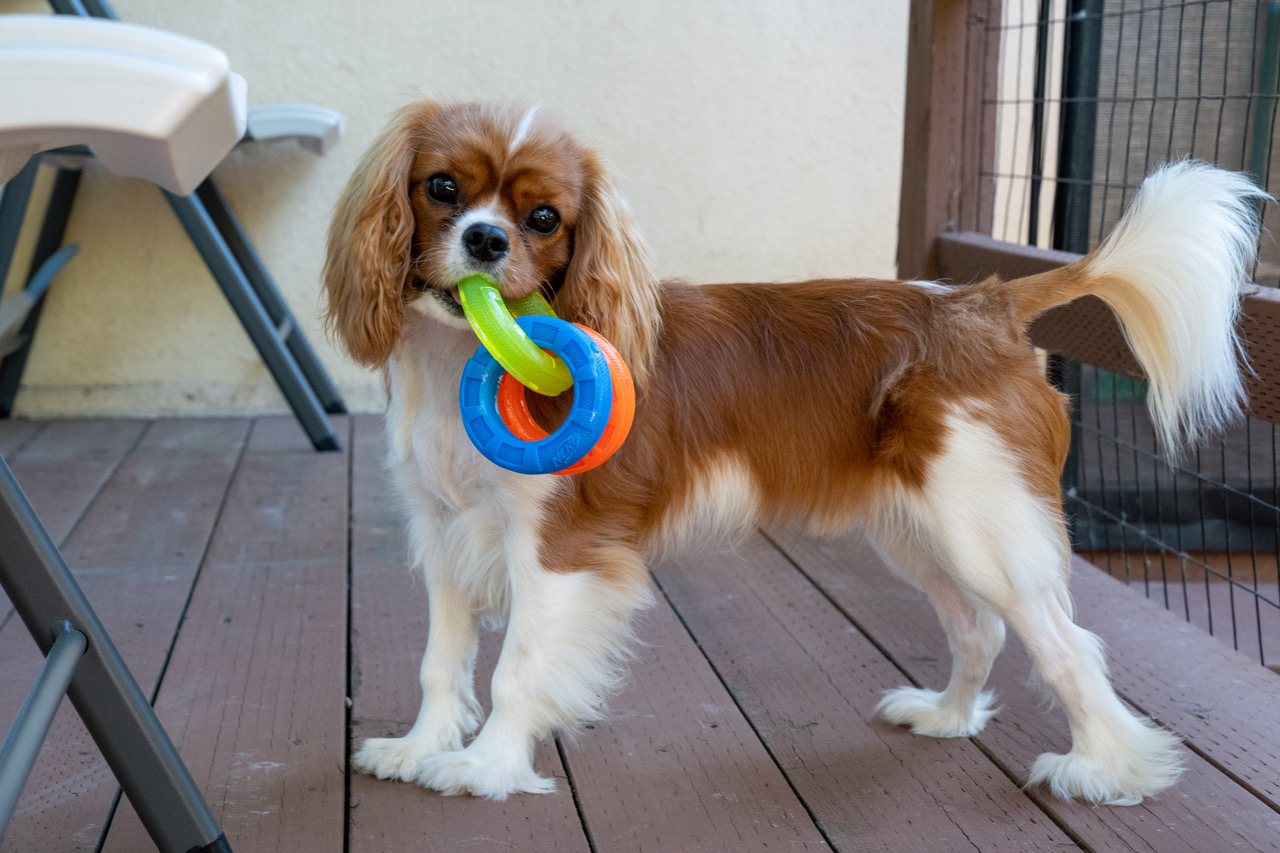The Emergency
Cannoli, an 8-month-old male Cavalier King Charles Spaniel, presented early one Monday morning obtunded, had been vomiting, started having seizures, and was unresponsive to stimuli. The NPVEC team sprung into action upon Cannoli’s arrival, placing an intravenous (IV) catheter to administer anti-seizure medication and IV fluids, providing oxygen support, and continuously monitoring vital signs to assess his response to treatment. He seemed to stabilize a bit, but was still unresponsive to stimuli.
 Four Days Earlier…
Four Days Earlier…
On the Thursday prior to coming into our hospital, Cannoli had apparently eaten an acorn. His owners saw him eat it but it resurfaced after Cannoli vomited a few times. Cannoli continued to vomit the next day, stopped vomiting over the weekend, but then worsened on Sunday evening. He became quite weak and appeared to have a grand mal seizure at home. After having another seizure Monday morning, the owners brought him to NPVEC for evaluation.
Treatment and Stabilization
With the initiation of intravenous fluids, injectable medications to stop the seizures, and treatment of his electrolyte imbalance, Cannoli started responding positively to treatment. He started returning to consciousness, held his head up a bit, and responded to auditory stimuli, but did not appear to be able to see. His pupillary responses were sluggish but present (a welcome sign), but he could not fully stand on all four limbs. Given the seizures he had suffered, it was not surprising that he was unable to see or stand.
With time and ongoing supportive care, we felt optimistic Cannoli would improve. His family admitted him to NPVEC and we performed a blood panel and radiographs, along with ongoing supportive treatment (intravenous fluids, broad-spectrum antibiotics, electrolyte correction) and monitoring key vitals (blood pressure, blood glucose, electrolyte, and oxygen saturation). He had another seizure a few hours after his arrival and more medication was given immediately to control the seizure.
Once Cannoli was stabilized and treatment was underway, we obtained a complete history from Cannoli’s owners including the crucial timeline for when he ingested the acorns and the ensuing episodes of vomiting.
Tiny Object, Big Problem
Our working differential diagnoses included gastrointestinal foreign body (perhaps an acorn or acorn fragment) or toxins from the acorn ingested. Ongoing concerns were that the acorn or possible toxins from ingesting it may be causing secondary problems such as sepsis, seizures, and electrolyte abnormalities.
The diagnostics revealed:
- Very low electrolytes
- Elevated white blood cell count, indicating inflammation and infection
- Likely intestinal obstruction visible on radiographs
We continued to treat Cannoli and although he was not yet completely stable, the decision was made to intervene with surgery the following day to relieve the intestinal obstruction.
“We’re Going In.”
We discussed the anesthetic, intra- and post-operative risks of gastrointestinal foreign body surgery with Cannoli’s family. They understood that we did not have any options other than surgical intervention at this juncture and that Cannoli’s prognosis was guarded. Our board-certified surgical specialist was called in to perform the procedure, and together with our phenomenal veterinary technician team, the surgery began.
Sure enough, foreign material that resembled fabric was found lodged in Cannoli’s intestinal tract causing the obstruction we identified on radiographs. During the procedure, Cannoli put our technician anesthetist through his paces with persistently low blood pressure readings despite intervention with vasopressors, increased fluid rates, and minimizing the flow of anesthetic agents to treat it. Our skilled surgeon worked quickly and efficiently to alleviate the intestinal obstruction while our trained veterinary technician team continuously titrated fluids, drugs, and anesthesia levels to manage Cannoli’s low blood pressure and maintain safe anesthetic depth. Our surgical specialist worked with skillful speed to safely complete the procedure and minimize Cannoli’s time under anesthesia, and to everyone’s relief, the obstruction was removed successfully. But our team still had a ways to go.
 Not Out Of The Woods
Not Out Of The Woods
Cannoli was a little fighter. Together with our surgical and anesthesia team, everyone prevailed for a positive outcome. But it was a fight to the finish for all. The surgeon had to ensure that there was no possibility of fluid leaking from the incision made in the intestinal tract during the foreign body removal and intestinal repair. Thorough flushing of the abdomen with sterile saline was performed to minimize any microbes remaining that may cause peritonitis or sepsis. The anesthesia team continued to manage Cannoli’s vitals (blood pressure, oxygenation, and heart and respiratory rates) and depth of anesthesia to ensure Cannoli would survive the effects of anesthesia.
Finally, the surgery was successfully completed and Cannoli recovered, albeit a bit more slowly than we anticipated. We breathed a collective sigh of relief at this outcome, all the result of teamwork from a skilled surgical and anesthetic team.
The Winding Road Home
Cannoli remained hospitalized for a couple more days on supportive care, antibiotics, pain management, and monitoring of his blood values. His blood protein values were low post-operatively, so he was also given a plasma transfusion the evening after surgery. We continued supplementing electrolytes throughout his hospitalization; his potassium improved but the sodium would take a bit more time. He started eating well on his own the day after surgery and was reunited with his family for ongoing care at home two days post-surgery.
When Cannoli returned for suture removal two weeks later, his normal puppy-like happy-go-lucky attitude had returned and it was clear he had recovered completely from his ordeal with the acorns. At the time of suture removal, he had fully regained his eyesight and was able to stand, walk, and run!
 The Takeaway
The Takeaway
Vomiting that occurs several times, and/or for more than 24 hours, requires evaluation by a veterinarian. Vomiting despite drinking water is also a problem. If your pet is vomiting persistently or for more than a day, call your family veterinarian or your local emergency veterinarian and seek help as soon as possible.
Cannoli’s story is one of many cases in which the outcome would have been much different depending on when his family sought help from a veterinarian. The sooner you have your pet evaluated for vomiting and intervention begins, the sooner your pet will improve and the lower the overall cost will be. And in most cases, a good outcome will ensue.
If you were vomiting for a day, you would likely call your doctor or seek assistance at the urgent care of the emergency. The same is true for your pets.
